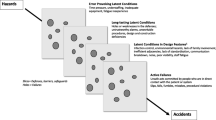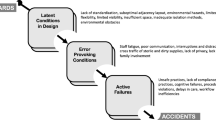Abstract
Purpose of review
Healthcare is a complex system where dynamic and unpredictable interactions of system components contribute to errors. In the design of a new healthcare facility, there is a need to increase levels of safety evaluation throughout all phases of hospital development as a means to manage risk. Simulation effectively represents the dynamics of care delivery in order to identify and remediate latent conditions in the built environment or work system prior to patient exposure.
Recent findings
Emerging literature suggests that the integration of human factor approaches with simulation-based activities has the potential to aid healthcare systems in achieving higher quality care. Simulation-based Hospital Design Testing (SbHDT) and Simulation-Based Clinical Systems Testing (SbCST) are applied in order to proactively identify latent conditions related to the built environment, work system, or care processes; ensure operational readiness; and ease transitioning healthcare systems by promoting preparedness.
Summary
Incorporation of simulation into the hospital development process places safety at the forefront of planning. By proactively identifying architectural or system weaknesses, corrective actions can be taken before harm occurs. This review discusses how simulation grounded in safety and architectural design concepts enhance safety evaluation during the development process.

Similar content being viewed by others
References and Recommended Reading
Papers of particular interest, published recently, have been highlighted as: • Of importance
Ulrich RS, Zimring C, Zhu X, DuBose J, Seo HB, Choi YS, et al. A review of the research literature on evidence-based healthcare design. HERD. 2008;1(3):61–125.
Provan D, Woods D, Dekker S, Rae A. Safety II professionals: how resilience engineering can transform safety practice. Reliab Eng Syst Saf. 2019;195:106740. https://doi.org/10.1016/j.ress.2019.106740.
Dube MM, Reid J, Kaba A, Cheng A, Eppich W, Grant V, et al. PEARLS for systems integration: a modified PEARLS framework for debriefing systems-focused simulations. Simul Healthc. 2019. https://doi.org/10.1097/SIH.0000000000000381. This study describes PEARLS, for systems integration, a conceptual framework and debriefing structure that is used during for debriefing simulations that are implemented to evaluate latent conditions within the work system.
Paige JT, Terry Fairbanks RJ, Gaba DM. Priorities related to improving healthcare safety through simulation. Simul Healthc. 2018;13(3S Suppl 1):S41–50. https://doi.org/10.1097/SIH.0000000000000295.
Joseph A, Rashid M. The architecture of safety: hospital design. Curr Opin Crit Care. 2007;13(6):714–9. https://doi.org/10.1097/MCC.0b013e3282f1be6e.
Reason J. Human error: models and management. West J Med. 2000;172(6):393–6.
Reiling J, Hughes RG, Murphy MR. The impact of facility design on patient safety. In: Hughes RG, editor. Patient Safety and Quality: An Evidence-Based Handbook for Nurses. Rockville: Advances in Patient Safety; 2008.
Wheeler DS, Geis G, Mack EH, LeMaster T, Patterson MD. High-reliability emergency response teams in the hospital: improving quality and safety using in situ simulation training. BMJ Qual Saf. 2013;22(6):507–14. https://doi.org/10.1136/bmjqs-2012-000931.
Weaver SJ, Lyons R, DiazGranados D, Rosen MA, Salas E, Oglesby J, et al. The anatomy of health care team training and the state of practice: a critical review. Acad Med. 2010;85(11):1746–60. https://doi.org/10.1097/ACM.0b013e3181f2e907.
Reiling J. Safe design of healthcare facilities. Qual Saf Health Care. 2006;15(Suppl 1):i34–40. https://doi.org/10.1136/qshc.2006.019422.
Geis GL, Pio B, Pendergrass TL, Moyer MR, Patterson MD. Simulation to assess the safety of new healthcare teams and new facilities. Simul Healthc. 2011;6(3):125–33. https://doi.org/10.1097/SIH.0b013e31820dff30.
• Torres-Landa S, Neylan C, Quinlan K, Klock C, Jefferson C, Williams NN, et al. Interprofessional simulations to inform perioperative facility planning and design. J Surg Educ. 2019;76(1):223–33. https://doi.org/10.1016/j.jsurg.2018.06.016. This study describes the role of simulation in evaluating a mockup of a proposed perioperative space. Based on participant feedback the perioperative design was modified resulting in increased satisfaction scores.
Villamaria FJ, Pliego JF, Wehbe-Janek H, Coker N, Rajab MH, Sibbitt S, et al. Using simulation to orient code blue teams to a new hospital facility. Simul Healthc. 2008;3(4):209–16. https://doi.org/10.1097/SIH.0b013e31818187f3.
Colman N, Edmond MB, Dalpiaz A, Walter S, Miller DC, Hebbar K. Designing for patient safety and efficiency: simulation-based Hospital Design Testing. HERD. 2020. https://doi.org/10.1177/1937586720921777. This study was a prospective investigation of Simulation-based Hospital Design Testing (SbHDT) in the schematic design planning phase for a 400-bed free standing children’s hospital. Results demonstrated a statistically significant reduction in risk through effective identification of latent conditions and validation of design changes.
Stone KHL, Reid J, Deutsch E. Systems integration, human factors, and simulation. In: Grant V, Cheng A, editors. Comprehensive Healthcare Simulation: Pediatrics Comprehensive Healthcare Simulation. Switzerland: Springer International Publishing; 2016.
Auerbach M, Stone K, Patterson M. The role of simulation in improving patient safety Comprehensive Healthcare Simulation. In: Grant V, Cheng A, editors. Comprehensive Healthcare Simulation: Pediatrics Comprehensive Healthcare Simulation. Switzerland: Springer International Publishing; 2016.
Colman N, Doughty C, Arnold J, Stone K, Reid J, Dalpiaz A, et al. Simulation-based clinical systems testing for healthcare spaces: from intake through implementation. Adv Simul (Lond). 2019;4:19. https://doi.org/10.1186/s41077-019-0108-7.
• Colman N, Stone K, Arnold J, Doughty C, Reid J, Younker S, et al. Prevent safety threats in new construction through integration of simulation and FMEA. Pediatr Qual Saf. 2019;4(4):e189. https://doi.org/10.1097/pq9.0000000000000189. This study discusses the integration of simulation and FMEA risk assessment in evaluating a new space for safety threats, workflow, and process inefficiencies in the post-construction environment, providing a framework for prioritizing issues with the greatest risk for harm.
Carroll JS, Rudolph JW. Design of high reliability organizations in health care. Qual Saf Health Care. 2006;15(Suppl 1):i4–9. https://doi.org/10.1136/qshc.2005.015867.
Weick KE, Sutcliffe KM. Managing the Unexpected: Sustained Performance in a Complex World. In: Jossey-Bass, editor. . 3rd ed. Hoboken: John Wiley & Sons Inc; 2015.
High Reliability. In Agency for Research Healthcare and Quality. 2019. https://psnet.ahrq.gov/primer/high-reliability. Accessed 16 May 2020.
Lipsitz LA. Understanding health care as a complex system: the foundation for unintended consequences. JAMA. 2012;308(3):243–4. https://doi.org/10.1001/jama.2012.7551.
Holden RJ, Carayon P, Gurses AP, Hoonakker P, Hundt AS, Ozok AA, et al. SEIPS 2.0: a human factors framework for studying and improving the work of healthcare professionals and patients. Ergonomics. 2013;56(11):1669–86. https://doi.org/10.1080/00140139.2013.838643.
Carayon P, Schoofs Hundt A, Karsh BT, Gurses AP, Alvarado CJ, Smith M, et al. Work system design for patient safety: the SEIPS model. Qual Saf Health Care. 2006;15(Suppl 1):i50–8. https://doi.org/10.1136/qshc.2005.015842.
Agency for Healthcare Research and Quality. Improve Patient Safety Through Simulation Research. Agency for Healthcare Research and Quality. 2018. https://www.ahrq.gov/research/findings/factsheets/errors-safety/simulproj11/index.html. Accessed 16 May 2020.
Joseph A, Quan X, Taylor E, Jelen M. Designing for Patient Safety: Develo** Methods to Integrate Patient Safety Concerns in the Design Process. Center for Healthcare Design. 2012;Appendix V. 105–116. https://www.healthdesign.org/sites/default/files/chd416_ahrqreport_final.pdf
• Bayramzadeh S, Joseph A, Allison D, Shultz J, Abernathy J, Group ROS. Using an integrative mock-up simulation approach for evidence-based evaluation of operating room design prototypes. Appl Ergon. 2018;70:288–99. https://doi.org/10.1016/j.apergo.2018.03.011. This study described the process and tools used as part of a multidisciplinary collaborative approach to the design and evaluation of operating room prototypes. Key design changes were made based on end-user feedback, highlighting the role of participatory and iterative design.
Alfonsi E, Capolongo S, Buffoli M. Evidence based design and healthcare: an unconventional approach to hospital design. Ann Ig. 2014;26(2):137–43. https://doi.org/10.7416/ai.2014.1968.
Patient room design checklist and evaluation tool. In The Center for Health Design. 2015. https://www.healthdesign.org/patient-room-design-checklist-and-evaluation-tool. Accessed 26 April 2016.
Davis S, Riley W, Gurses AP, Miller K, Hansen H. Failure modes and effects analysis based on in situ simulations: a methodology to improve understanding of risks and failures. In: Henriksen K, Battles JB, Keyes MA, Grady ML, editors. Advances in Patient Safety: New Directions and Alternative Approaches (Vol 3: Performance and Tools). Rockville: Advances in Patient Safety; 2008.
Thornton E, Brook OR, Mendiratta-Lala M, Hallett DT, Kruskal JB. Application of failure mode and effect analysis in a radiology department. Radiographics. 2011;31(1):281–93. https://doi.org/10.1148/rg.311105018.
Institute for Healthcare Improvement. Failure Mode and Effect Analysis Tool. Institute for Healthcare Improvement. 2017. http://www.ihi.org/resources/Pages/Tools/FailureModesandEffectsAnalysisTool.aspx. Accessed 12 Sept 2018.
DeRosier J, Stalhandske E, Bagian JP, Nudell T. Using health care failure mode and effect analysis: the VA National Center for patient safety’s prospective risk analysis system. Jt Comm J Qual Improv. 2002;28(5):248–6709.
Health Quality Council of Alberta. Simulation-Based Mock-up Evaluation Framework. Calgary Alberta, Canada. 2016.
Taylor E, Hignett S, Joseph A. The environment of safe care: considering building design as one facet of safety. Int Symp Hum Fact Ergon Healthc Care: Adv Cause. 2014;3:123–7.
• Wingler D, Machry H, Bayramzadeh S, Joseph A, Allison D. Comparing the effectiveness of four different design media in communicating desired performance outcomes with clinical end users. HERD. 2019;12(2):87–99. https://doi.org/10.1177/1937586718796626. This study compared effectiveness of four different design communication media in conveying structural and functional information to clinical end users. Results demonstrated that more immersive media such as mockups increased understanding of proposed design.
Ventre KM, Barry JS, Davis D, Baiamonte VL, Wentworth AC, Pietras M, et al. Using in situ simulation to evaluate operational readiness of a children’s hospital-based obstetrics unit. Simul Healthc. 2014;9(2):102–11. https://doi.org/10.1097/SIH.0000000000000005.
Bender J, Shields R, Kennally K. Testing with simulation before a big move at Women & Infants Hospital. Med Health R I. 2010;93(5):1459-50.
Francoeur C, Shea S, Ruddy M, Fontela P, Bhanji F, Razack S, et al. It takes a village to move a hospital: simulation improves intensive care team preparedness for a move to a new site. Hosp Pediatr. 2018;8(3):148–56. https://doi.org/10.1542/hpeds.2017-0112.
Hollnagel E. Prologue: Why do our expectations of how work should be done never correspond exactly to how work is done? In: Braithwaite J, Wears R, Hollnagel E, editors. Resiliant Health Care III: Reconciling work-as-imagined and work-as-done. Boca Raton: CRC Press, Taylor & Francis Group; 2017.
Acknowledgments
We acknowledge members of the simulation centers at Children’s Healthcare of Atlanta who has diligently worked to deliver SbHDT and SbCST. The simulation community’s knowledge sharing, sharing of success, and failures have played a role in the completion of this manuscript.
Author information
Authors and Affiliations
Contributions
All authors are familiar with submission instructions and are responsible for the content of the manuscript. NC performed background research; conceptualized the manuscript; prepared the article, modified, and revised the tools included in this manuscript; and approved the final version as submitted. KH oversaw the concept and design of this innovation, reviewed, and revised the article, and approved the article as submitted. AD reviewed and revised the article and approved the article as submitted.
Corresponding author
Ethics declarations
Conflict of Interest
Nora Colman declares that she has no conflict of interest. Ashley Dalpiaz declares that she has no conflict of interest. Kiran B. Hebbar declares that he has no conflict of interest.
Additional information
Publisher’s Note
Springer Nature remains neutral with regard to jurisdictional claims in published maps and institutional affiliations.
This article is part of the Topical Collection on Patient Safety
Rights and permissions
About this article
Cite this article
Colman, N., Dalpiaz, A. & Hebbar, K.B. Simulation Enhances Safety Evaluation in the Design of New Healthcare Facilities. Curr Treat Options Peds 6, 214–225 (2020). https://doi.org/10.1007/s40746-020-00202-7
Published:
Issue Date:
DOI: https://doi.org/10.1007/s40746-020-00202-7




